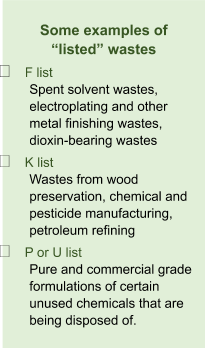Are You Improperly Storing a Hazardous Waste You Didn’t Know About?
January 12, 2021
Here’s What to Do If You Think You Might Be Improperly Storing a Hazardous Waste
It’s extremely important to not be improperly storing hazardous waste. Eye of newt? The toe of a frog? The wool of bat?
Federal hazardous waste management regulations apply to most businesses that generate hazardous waste. So it behooves you to know whether or not what’s oozing & bubbling in those cauldrons behind your factory is hazardous waste—and how to store it properly.
And getting “behooved” isn’t as easy as it might seem.
For example, while eye-of-newt, toe-of-frog, or wool-of-bat can be innocent enough in isolation, they might not play nice together, becoming “reactive” when in close quarters. So you might want to get some expert advice before dumping them into the same drum—although we confess to a certain naivete when it comes to witch’s ingredients and their industrial applications.
So what’s the definition of hazardous waste?
Per the EPA, a “waste” is any solid, liquid, or contained-gas that’s discarded by being disposed of, incinerated, or recycled. It might be the byproduct of your manufacturing process; or some spent agent you routinely use in your enterprise, such as cleaning fluid, a chemical catalyst, battery acid, or anything else that lands on the wrong side of “eco-friendly.”
And we’re not just talking trash. Even recyclable materials that you intend to use, sell, or give away might require hazardous waste management during their onsite storage prior to hazardous waste removal from your property.
With what types of hazardous waste are you possibly dealing with?
The EPA sorts hazardous waste across two flavors: “listed” and “characteristic.” 
Listed wastes. You have a “listed” waste on your hands if it appears on one of four lists published in the Code of Federal Regulations (40 CFR Part 261). These are named F, K, P, and U—standing for…who knows? Anyway…
When we last checked, there were more than 500 wastes named across the four lists, which means—yes—that mystery pudding served in the company cafeteria is suspect, although it’s probably not an “acute hazardous waste,” which is something so egregious that it can be fatal even in low doses. (Pesticides are prime culprits.)
Characteristic wastes. Something that fails to appear on the F, K, P, or U hazardous-waste lists might nonetheless be considered guilty if it exhibits one or more of the following “characteristics.”
- Flammability—catches fire under certain conditions
- Corrosiveness—disintegrates metals
- Instability—prone to explode under heat or pressure; or produce toxic fumes, gasses, or vapors
- Toxicity—harmful or fatal when ingested or absorbed, or can leach into soil or groundwater
Hazardous waste accumulation
Once you know you’re dealing with hazardous waste, bear in mind that the EPA allows you to accumulate it onsite only for a relatively short period of time prior to its disposal or recycling, otherwise you need a TSDF permit (see below).
While the waste is languishing on your site, you’re responsible for its hazardous waste management, which includes safe storage, safe treatment, accident prevention, and emergency response—all in accordance with federal, state, and local regulations.
So how long can you store hazardous waste onsite without a permit?
When the permit-requirement kicks in depends on whether the EPA considers you either a “very small quantity generator” (VSQG) or a “small quantity generator” (SQG).
Again we cannot overemphasize: get expert advice if you even think that you’re storing hazardous waste onsite. But assuming you’re a VSQG (producing 220 lbs. or less of hazardous waste monthly) or an SQG (producing more than that up to 2200 lbs. monthly), here’s the upshot:
- You can accumulate up to 13,228 lbs. of hazardous waste onsite for up to 180 days without a permit—or up to 270 days if you have to move it more than 200 miles for recovery, treatment, or disposal.
- Limited extensions might be granted by the state director or the regional EPA administrator.
- If you exceed these limits, you’ll be considered a “treatment, storage, and disposal facility” (TSDF) and required to obtain the appropriate operating permit to carry on without fines and other ugly legal ramifications.
- You can store wastes generated in small amounts throughout your facility in “satellite accumulation areas” located nearby the generation of the waste—limited to 55 gallons—after which the waste must be transferred to your 180- or 270-day storage area.
- Different quantity limits apply to acutely hazardous wastes. Again: get expert advice.
What vessels to use?
For VSQs and SQGs, hazardous waste must be collected in EPA-approved tanks or containers, such as 55-gallon drums, and managed as follows:
- Each container must be labeled with the words “HAZARDOUS WASTE” along with the date its contents were generated.
- Such a container must be composed of (or lined with) a material that will not be corroded by or reactive with the hazardous waste being stored.
- Hazmat containers must remain closed; be opened only to add or remove waste; and protected against rupture, leakage, or other types of failure.
- Areas in which containers are stored must be inspected weekly for leaks, corrosion, or other factors that might lead to less-than-ideal consequences.
- Wastes mustn’t be comingled or added to other materials that might cause them to become reactive.
Conclusion
As we’ve counseled before, the RCRA makes it remarkably easy to be a hazardous waste generator. E.g., the moment you uncork a can of solvent and use it, you’ve joined the ranks; and the improper storage or disposal of even a small amount can land you squarely in the crosshairs of the EPA, which is not a good place to be.
Get expert advice here. And thank you for reading our blog!

